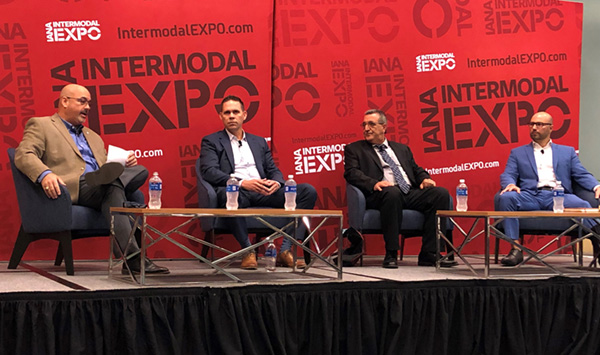
Freight needs to move,and something needs tobe done about it.
That was the overarching sentiment expressed by executives of some of the country’s busiest marine terminals who gathered recently to discuss cargo congestion, chassis, on-dock rail, truck appointment systems and upcoming labor contracts at the annual Intermodal association of North America (IANA) Intermodal EXPO in Long Beach, California.
The “Inside Marine Terminals” panel Sept. 14 included Sal Ferrigno, vice president of SSA Terminals; Jon Poelma, managing director of APM Terminals; Brian Kobza, director of sales and marketing at GCT USA; and the panel’s moderator Rob Cannizzaro, vice president of operations at Virginia International Terminals, Inc.
Panelists launched the hour-long conversation with how vessel scheduling challenges affect operations and how they manage them.
Ships have been at anchor for 10 days waiting for berths in some instances, one panelist said. Another said the unpredictability has made it difficult to plan for equipment and labor.
“It’s really been rough with the ocean carrier schedule reliability,” said Poelma, adding that even the best performer, in some cases, is running at 45% reliability. “There’s been a tremendous amount of fluctuation in the volume.”
Panelists said they’re focused on trying to move as much cargo as quickly as possible and are working with stakeholders to make it happen.
“We’ve actually spoken to our main carrier customers and asked them about this and if there’s any plans to come back to an on-performance schedule, and they’ve told us candidly that that’s not really a priority for them right now,” Cannizzaro revealed.
They understand that this is the new normal and they are processing as many boxes as they can when they arrive, he added.
“The only answer to the question in Virginia is that we have some excess capacity available, so we are able to service ships with limited negative impact,” Cannizzaro remarked.
Chassis
Panelists were also asked about chassis and their impact on operations.
Poelma said that at Port Elizabeth a few years ago, APM moved chassis’ off dock to where International Longshoremen’s Association members repair them and truckers pick them up. There’s also many driver-owned and driver-leased chassis that drivers themselves maintain.
APM has said that it monitor the situation long-term, especially interactions with the ILA and the mechanics, he said.
“But right now, it works quite well, and we’re able to use that space on the terminals that had chassis out there,” Poelma remarked.
About 85% of the cargo coming to New York/New Jersey is going out on trucks, Kobza said.
“So those chassis are sitting in those warehouses for way too long, not turning fast enough,” he remarked. “I don’t believe that it’s the actual quantity of chassis that are the issue. It’s the amount of dwell time and the IEPs (intermodal equipment providers) are doing the best they can to make them available whenever they can.”
SSA, which has its own chassis pool, brought in 1,000 new chassis six months ago, Ferrigno said.
“They disappeared in a week, and it’s like we never on-hired anything,” he explained, adding that the current problem with chassis is dwell time.
“When you go from a four-and-a-half day dwell to nine-day dwell, you need to double those chassis just to keep up, and there is no way anyone’s going to take that risk,” he remarked. “We’ve had the opportunity to buy 3,000 new chassis now and I can’t do it, because next year, when things go back to normal, what am I going to do with these assets? I spent $50 million on something that’s just going to sit in the yard? And I have to look for storage space for these chassis?”
Yard labor has gone up 30% per container, Ferrigno added. He said that more resources are going to the yard and away from the ship.
“We have the same problem as the chassis people,” he said. “What do we do? Hire thousands of new people and then a year from now, we don’t need them and pay them guaranteed? So we have to be careful on how we do things. If we knew this was the new norm, that would be different.”
The root of the problem needs to be addressed: warehouses need to start moving cargo, but they, like drivers, don’t have enough employees to unload shipments fast enough, Ferrigno explained.
“Until that’s fixed, I hate to say it, but we’re not going to see a change,” he remarked. “You’re going to see 50 ships out there unless we start diverting
these ships elsewhere…the cargo needs to start moving.”
On-Dock Rail
Terminal operators said they want to see more cargo move directly from ship to rail cars.
“It’s a great opportunity for us to drive more volume through the terminal without worrying about the space constraints that we’ve been talking about,” Poelma said.
Kobza said he’s seeing mostly controlled dwell time on rail cargo and that drives up capacity, resulting in higher fluidity and efficiency.
“We’re actively trying to convert anything that’s moved by truck onto rail with our railroad partners,” he said.
Ferrigno said he also likes rail, but that cargo isn’t moving.
“At places like Oakland, we have zero ships waiting for berths. We have customers that want to bring us more ships. I have to ask, how much rail do you have? ‘Well, I have this much rail.’ Well, the rail is going to sit there for 16 days, we can’t take your ship. So we’re turning away business because the rail can’t move the containers fast enough.
“And it’s not that they’re incapable of doing it,” he explained. “They’ve done it in the past, but they have the same problem everyone else has. All around the country, they’re all full. And you ask them, why are they full? They say, well, the warehouses can’t unload them.”
At Los Angeles/Long Beach, there were 5,000 containers sitting at one time, Ferrigno said.
“And you’ve got to understand, we can only do 500 a day,” he said. “Right now, we’re always hovering around 1,500-2,000 units sitting there on a daily basis. It’s just still not moving fast enough.”
In Virginia, where upgrades to two container facilities have been completed, there’s space, chassis and fluidity to accommodate cargo. However, problems in Chicago and Columbus are having an impact on velocity, Cannizzaro said.
“In some cases, there’s a disconnect between the velocity of the vessels and the velocity of the rail cargo that we see a pile slowly growing, that we have to keep fighting back down by having discussions and making agreements with the railroads to keep that fluidity,” he said. “In some cases, we have more imports and exports and we’re faced with more cargo than we have railcars.”
Reservation Systems
Many on the panel spoke about the benefits of implementing terminal reservations systems.
“If you haven’t had it, now’s the time,” Kobza remarked. “It certainly should make your flow go quicker.”
Reservation systems allow terminal operators to create more predictability in the supply chain, provide better service for the trucking community, and offer ways to pre-stage cargo internally at a lower cost, he explained, adding that in New York for GCT, the system was implemented slowly, eventually expanding the appointment window.
“We see a general market improvement on the service levels,” he said. “Life’s a little crazy right now with the peaks of different ships showing up, but we’re working through it, trying to further invest in the appointment system and try to deliver better service.”
At Port Elizabeth, nearly $30 million was dedicated to developing the appointment system and a new gate complex, Poelma said.
“It’s mandatory all day long, all types of moves, and it’s really helped us to establish a flow,” he said. “So for us personally, the next challenge is the flow inside the terminal. So we move the bottleneck probably from the in/out gate back into the yard.”
Cannizzaro said that in Virginia, the benefits for a reservation system are apparent.
“We actually have the opportunity to housekeep or pre-stage prior day reservations for the following day,” he said.
For example, containers being picked up for a 5 a.m. appointment made on Tuesday for Wednesday morning can be placed on the top of the stack closest to the landside transfer zone. Then containers for 6 a.m. appointment pickups would be placed below it and 7 a.m. pickups below the 6 a.m. pickups.
“That motor carrier who makes a priority appointment gets a bespoke experience,” Cannizzaro said. “He’s guaranteed to have no rehandling to get this container delivered.”
Same day appointments, however, present more of a challenge, he said.
“It doesn’t allow us to housekeep that container, so we’re looking for ways and ideas to incentivize prior day appointments without limiting the ability to transact the same day because we know that’s important for carriers in some respects,” he explained.
Kobza added that there needs to be flexibility.
“It’s a dynamic system,” he said. “If you cancel an appointment that day, it immediately becomes available for somebody else. And so the other part we’re trying to incentivize is if you’re not going to come to your appointment, cancel it so somebody else can use it.”
Poelma agreed, adding that he sees roughly 15% of those appointments cancelled.
“We’re trying to incentivize that behavior where they cancel the appointment,” he said. “If you’re not going to use it, if your driver is stuck, just call your dispatcher, cancel the appointment and free it up for somebody else. Because the truckers want that appointment and we need to move that freight. We’re all kind of operating on the knife’s edge right now, so we need to move that freight.”
Labor
Panelists lauded the hard work and dedication of labor workers throughout the COVID-19 pandemic and in some cases, in the face of torrential weather.
“There were a lot of reasons to try and stay home, but they got the job done, and somehow we made it through these incredible times,” Poelma remarked.
With regards to the International Longshore and Warehouse Union contract expiring July 1, 2022 and the ILA contract in 2024, panelists pointed to automation as a potential issue in talks.
“There’s a lot of eyes on the East Coast as to what happens with the West Coast,” Poelma said.
However, panelists were optimistic that negotiations will go smoothly this time around.
“Knowing the current leadership that the ILWU has today, I really don’t think we’re going to have the same problems we had in 2014,” Ferrigno said. “There are some pretty good guys out there that are levelheaded. No one wants to see service disruptions on either side, so I’m not expecting to have a big problem this time around. Keep our fingers crossed.”

